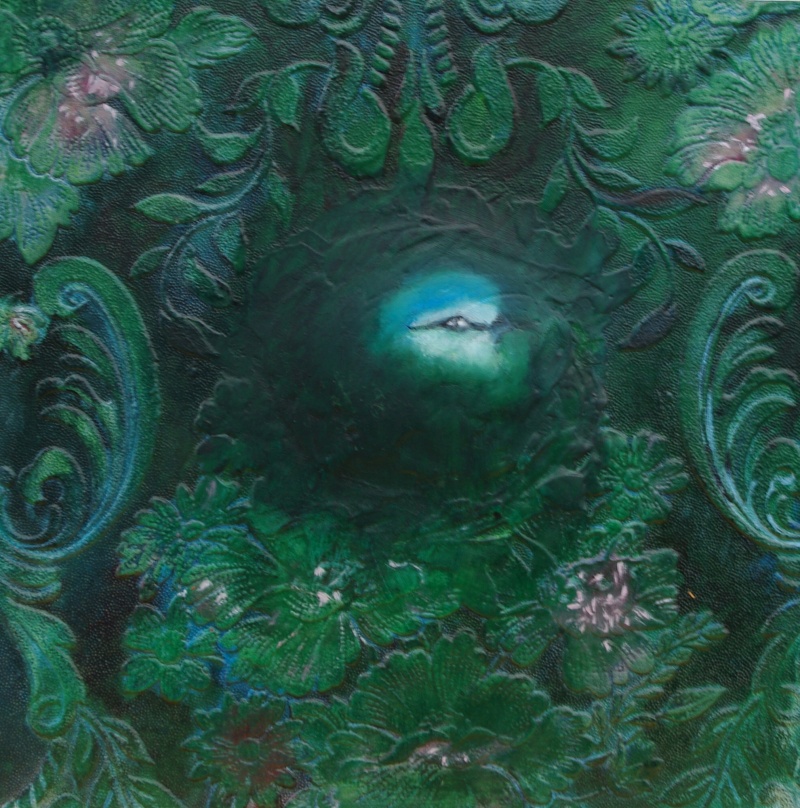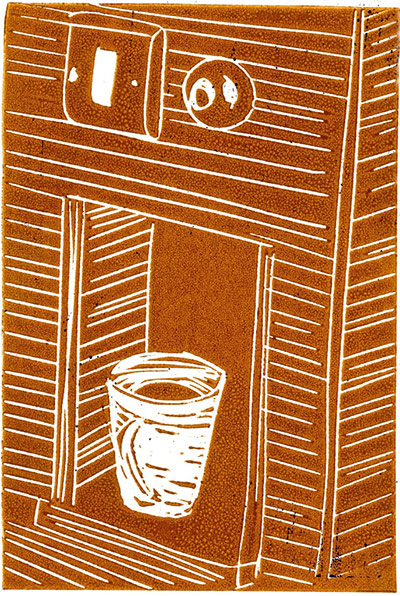

Crescent Artspace
TRAVELOG
Susan Slann
A new installation of painting, prints and found material.
Sat 10th November – Sat 15th December 2012
Thursdays – Saturdays 11.00am – 4.00pm
and by appointment
Admission is free.
Everything was as it should be. Pulling off the motorway and into the
service station, she drove round an empty car park behind the petrol pumps,
shop and American-style diner. There it was, just as the small photograph
had shown on the website when she had booked the week before.
The architecture, whilst lacking in distinction, wasn’t strictly functional.
The single storey building had a ranch-like quality, perhaps based on a marketing
department’s concept of a motel as seen in some half-forgotten movie.
It was domestic in scale and appearance and could easily have been mistaken for
a community centre on any housing estate anywhere in the country.
The feeling of familiarity offered by this first impression, whilst comforting,
was accompanied by a faintly unsettling sense of déjà vu.
She went in and the door swung to behind her, shutting out the incessant noise
of motorway traffic to which she had been oblivious until this moment of absence.
A cocoon of silence enveloped her and, as her ears became accustomed to her
surroundings, she thought she could distinguish muffled voices somewhere nearby.

Travelog, Susan Slann, Lino Cut, 2012
There was no one about. The lobby and reception were deserted.
A drinks machine stood in one corner, too large for the space.
Its faux-wood facia matched nothing else. A plastic cup was placed in the
cavity at the front in anticipation of dispensing beverages. She noticed a floorplan
fixed to the wall next to the reception desk. She crossed the lobby, her footsteps
leaving no trace on the course grey-blue carpet tiles which absorbed all sound,
wear and tear. The faint murmur of voices continued, merging with the distant hum
of machinery; perhaps a vacuum cleaner or air conditioning.
After several attempts, hindered by an irrational feeling of increasing anxiety,
she let herself into room 301. The curtains were closed and there was a slightly
musty odour, but the room appeared to be clean. The curtains, which were of a
stiff synthetic fabric formed into pleats, covered the window area exactly with
no extraneous material. Their blue-grey decorative pattern seemed incongruous,
except that its grid-like motif was consistent with the spare décor of the room.
She checked the bathroom. It was brightly lit, in contrast to the dimmed
overhead lighting of the bedroom. A small portion of white soap, wrapped in a
cellophane pack bearing the company logo, was balanced on a pair of clear plastic
cups upended on a formica shelf. The double toilet roll holder was reassuringly
stocked up, thus obviating the need to call room service. The tiles around
the bath shower cubicle showed the random traces of perfunctory wiping and
a few droplets of water still clung to the shiny white shower curtain.
Back in the bedroom, she noticed a copy of The Bible in the half-opened
drawer of the bedside cabinet. A cordless kettle and two white mugs stood on
the dressing table work surface beneath a wide mirror, which effectively doubled
the size of the room. On closer inspection she realised that one of the mugs was
the reflection of the other. Next to the kettle, she found a small tray which contained
four sachets of instant coffee, some sugar, two small tubs of UHT milk and a tea spoon.
Travelog, Susan Slann, Lino Cut, 2012
She filled the kettle in the bathroom and boiled it for coffee.
The sofa was too firm and not very comfortable, so she chose to sit in the white
plastic chair and put her feet up on the bed. Gazing around the room she saw
that the paintwork was shabby and that the walls over the radiators were slowly
blackening from heat. Here and there, other indefinable traces betrayed signs
of previous occupancy.
Her attention was drawn to a painting on the wall opposite the bed.
From where she sat it reminded her of a painting that she had seen somewhere
before in an exhibition, Altermodernism perhaps, but which she could not positively
identify. The gestural brush marks in red and blue held her attention for several minutes
as she tried to remember this other painting and where she might have seen it.
As she drank her coffee she found she could not retrieve the absent painting,
which surely existed somewhere in her memory. She got up out of the chair and walked over
to inspect the canvas on the opposite wall. It wasn’t a painting after all, at least not
as she had supposed.
The ‘Travelog’ describes a seemingly pointless journey, moving from one Travelodge
hotel to another, recording the experience through a kind of visual diary; using printed
lino-cut images to illustrate various aspects, which are familiar to these iconic low budget hotels.
Travelodge has become part of our social landscape. The memories we hold of these hotels
are usually linked to other experiences; journeys for occasions, business, pleasure, holidays,
love, death and sorrow. They are the functional stays of convenience, with the provision of
basic needs and low expectation.
A room at a Travelodge provides refuge and anonymity.
You know what you are getting, therefore there can be no disappointment.
Susan Slann 2012
Susan Slann is a resident artist at Crescent Arts, where she has been working from her studio
over the past two years. Prior to this, her last solo exhibition was at Summit Print in
Kirkbymoorside in 2008. Susan has participated in several recent group exhibitions including
‘Home’, Leeds (2011); ’53 Degrees North’ (2010) at Schoolhouse Gallery, York; Ryedale Folk
Museum, Hutton-le Hole (2010); Leeds Open (2010); Ferens Open, Hull (2008/10).
She has shown new and collaborative work at Crescent Arts on a number of occasions,
within group exhibitions including The Drawing Room (2011); Supermart (2012) and
Soundings (2012). She was short-listed for Bloomberg New Contemporaries in 2007.
She completed an MFA at Leeds University in 2010 following a BA Fine Art at
University of Hull (2007) and Diploma in ‘Art in a Social Context’ at Dartington
College of Arts (1983).
For further information please visit www.susanslann.com
Artist review
'Susan Slann successfully provides a psychedelic, illuminating riot of colour in her images that turns some of traditional painterly formality on its head. Her works range from larger, rainbow-like waterfalls of frothy colour to liquid-like studies of unnerving texures and forms. There are traces of violent painting technique in the works, overlaid with familiar patterns and detailed descriptions of half recognisable forms - hair, cerebrum - that mutate into repeated strokes and interlocking marks. The embryonic colour studies show a certain playfulness within the formal watercolour tradition. This is drawn through the bubbly, ethereal softness of the paintings, all of the hiding a strong spontaneity beneath the surface'. - Eleanor Snare, from 'The Culture Vulture', July 2010.




